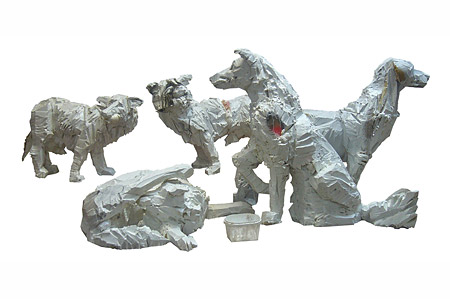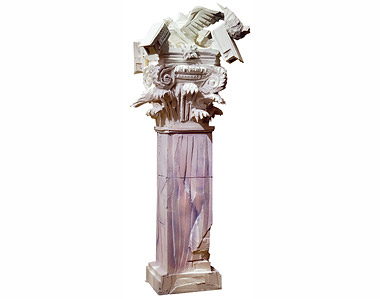 |
Sergey Shekhovtsov. The styrofoam project of freedom
Sergey Shekhovtsov, after studying at the Surikov Fine Art Academy and the Institute for Problems in Contemporary Art, has changed from a painter into a radical sculptor, who has chosen to work with Styrofoam, the material of postproduction and packaging, trash, and refuse that is ready to take on any form. Shekhovtsov has reformulated sculpture and deprived it of its birthright pathos. He shows the world as a synthetic illusion, as a total readiness for mutation. His ironic objects refer to different inflections and different points of the artistic tradition - antiquity and Pop Art, totalitarian visuality and ancient sacred objects. His styrofoam Pop Art both praises modernity and denigrates it. Shekhovtsov is as much an emblematic artist for the 2000s as the Soviet Non-Conformists were for the 1960s.
Alexander Evangely
|
 |
Born in 1969 Salsk, Russia
In 1996 graduated from Surikov Art College, Moscow
Lives and works in Moscow
|
|

Sergey Shekhovtsov. Dogs
2007.
Installation, styrofoam, dimensions vary
|
|

Sergey Shekhovtsov. Column
2007.
Styrofoam sculpture, 240õ70õ70 cm
|
|
Àlexander Åvangely: With what is the aesthetic of povera connected for you?
Sergey Shekhovtsov: For me, the aesthetic plays no role. For me, plastic foam is just a material from which I can make large objects, large installations and projects. It seems to me that given the availability of expensive commercial art, it is precisely "poor" art that points to the existence of a different space. I have never claimed to be on the left; it's more that I declared material as simply material because that is precisely where my freedom is. For me, the material is a project of declaring freedom, freedom of the artist's space, as if to say "There is something in the air here, here is my story."
À.Å.: When you lived in the squat on Baumanskaya Street, you had large painted works, which in various ways thematized the "poor." In that brief post-Perestroika period, even the simple proclamation of unwashed reality looked political. And after that gray, bleak, compassionate painting, it was surprising to find you in a different space with different themes; you acquired a kind of Pop-artistic boldness, which one did not read in your early critical works.
S.SH.: I can explain that for you. All those projects that I made about the post-Soviet - a space that will never exist - it was all my personal inner affections, and it has nothing to do with the state. It is a part of my childhood, it is dear to me, and the works are dear to me, but for me as an artist, there exist more important things behind which the term "motherland" does not stand. For me, there exist the terms "freedom" and "space." All of my projects with foam are connected with them; for me, that is what's most important. And the transition to a spatial form, to sculpture, meant only freedom. The question is very simple: I found I wanted to be a sculptor, and I am proving that. And the rest - styrofoam or no styrofoam, plaster or no plaster - does not concern me, it's not interesting. What interests me is the freedom of relating, of reacting, the artist's freedom, absolute freedom, which depends neither on a gallerist nor on a curator; it is my personal space.
|
 |
À.Å.: It's curious that you associate freedom with institutional independence. How did styrofoam come about, what circumstances accompanied it - there was no money, no prospects, you just had a kid; do you remember?
S.SH.: No, absolutely nothing stood behind it - I remember that moment. There was no money, of course, there was nothing, but that was connected only with the feeling of freedom and the search for it. And it was not connected with prospects - I had only a very vague idea about the history of art back then. Which, by the way, is a common story for provincial art - it's the advantage of making a mistake when you do something interesting due to a lack of knowledge, and then you analyze and begin to understand. I was busy with some three-dimensional things back then - I made objects, reliefs. It was important for me to find a different area other than painting or media on paper. I thought for a bit and found this shit. It was a personal project which, so it seemed, had nothing to do with art. I doubted for a long time whether I was a sculptor. But when you see your own sculpture in a museum to the left of the great Giacometti - it dawns on you that maybe it's not shit, maybe you too understand something about the matter. It's a question of a desire for form, and there is nothing else that stands behind it; any form: chocolate, lipstick, styrofoam, plaster, bronze - it doesn't matter. For now, I want to create out of what I have and to work with a small budget. Perhaps I'll change.
À.Å.: Your project for Russian Povera is largely connected to playing with materiality; something heavy - tradition, architecture - is carried off by the wind as if it is weightless and paltry. What's behind this, besides formal play?
S.SH.: The idea of the installation is, for me, simple and obvious: when architectural items fly away, it's about the illusory nature of many things. For me, the situation when everything is falling apart, changing, flying away is a situation of deception, but the kind of deception that I love and in which I live.
With the help of the material, the object can change and mutate in contemporary space. How can it change? For me, that is important and interesting; it's an experiment. What mutates is the very space which surrounds us; a moment comes when everything suddenly expands, changes, and you don't understand whether it's truth or lies.
|
|
SELECTED SOLO EXHIBITIONS
2008 Throne. Xl Gallery, Moscow
2006 Park. Nina Lumer Gallery, Milan, Italy
Foam-rubber. Anna Nova Gallery, St. Petersburg, Russia
Zoo. Orel Art gallery, Paris, France
2004 Ephemeral Art. State Tretyakov Gallery, Moscow
Potpourri. Regina Gallery, Moscow
Golden Cage. Regina Gallery, Moscow
Singer. State Tretyakov Gallery, Moscow
2003 Occupation of Elite (together with Valery Koshlyakov), Regina Gallery, Moscow
2002 Chicks. Regina Gallery, Moscow
Fozy. France gallery, Moscow
|
 |
SELECTED GROUP EXHIBITIONS
2008 Russian Povera. Project by Sergey Gordeev. Curator - Marat Guelman. Rechnoi Vokzal, Perm
2007 Capricci. Casino Forum d'art contemporari, Luxembourg
I believe. Special Project in the framework of 2 Moscow Biennale of Contemporary Art, Moscow, Russia
2005 Europalia. Russia, Brussels, Belgium
Russian Pop-Art. State Tretyakov Gallery, Moscow
ART-COLOGNE 2005, (Regina Gallery), KoelnMesse, Cologne, Germany
Art-Moscow 2005, (Regina Gallery), Central House of Artist, Moscow
Special project for Vienn Art Fair 2005, (Regina Gallery), Messecenter, Vienna, Austria
2004-2005 Warszawa-Moskwa 1990-2000, Warsaw, Moscow
2004 26 Bienal de Sao Paulo, Ciccillio Matarazzo Pavilion, Sao-Paulo, Brasil
Workshop Art Moscow Black Square, Central House of Artist, Moscow
Cinema. Project rooms in ARCO-2004, (Regina Gallery), Parque Ferial Julian Carlos I. Madrid, Spain
2003-2004 ART-COLOGNE 2003 - 2004, (Regina Gallery), KelnMesse, Cologne, Germany
Russia, forward! Regina Gallery, Moscow
Art-Moscow-2004, (Regina Gallery), Moscow central House of Artists
2002 POP-ART. Zverev Center of Contemporary Art, Moscow
Davaj, Russian Art Now! Postfuhrant, Berlin
Davaj, Russian Art Now! MAK, Vienna
Art-Moscow-2002, Karenina Gallery, Moscow central House of Artists
Third Russian Avantgarde. Karenina Gallery, Wien
2001 Typical - untypical. Artistic Squat on Baumanskaya, Moscow
2000 Abramtsevo-2000, Abramtsevo Museum, Moscow region
|
 |
|
 |